Charts of the Week
Current economic trends from 7 June to 11 June 2021: traffic of electronically tolled vehicles, electricity consumption, electricity consumption by consumption group, registered unemployment and other charts
In April, trade in goods remained at a high level, and production volume in manufacturing increased; both indicators exceeded pre-epidemic levels. In early June, the volume of freight traffic on Slovenian motorways was high, but slightly below the level of the same period in the pre-crisis year 2019. Electricity consumption was also up year-on-year but was slightly lower than before the crisis, probably mainly due to the reduced activities in tourism. The number of registered unemployed continued to decline in early June, and was only about 3% higher than in June 2019 and almost a fifth lower year-on-year.
Traffic of electronically tolled vehicles on Slovenian motorways, June 2021
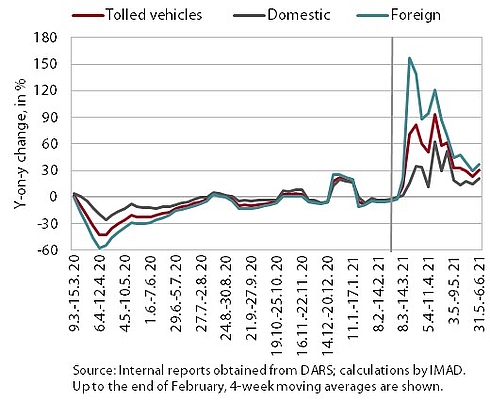
Freight traffic on Slovenian motorways in the first week of June was 30% higher than in the same period of last year but 3% lower than in the same period of 2019. Despite public holidays and days off during weekdays in three neighbouring countries, the volume of freight traffic was still relatively high and was, as expected, slightly lower (4% higher for domestic vehicles and 7% lower for foreign vehicles) compared to the same week of the pre-crisis year 2019, when there were five working days in all these countries. Between 31 May and 6 June, domestic vehicle traffic was 21% higher and foreign vehicle traffic 37% higher year-on-year. This strong year-on-year growth was still mainly a consequence of lower traffic in the same period of last year due to the first wave of the epidemic (when freight traffic of foreign vehicles declined more).
Electricity consumption, June 2021
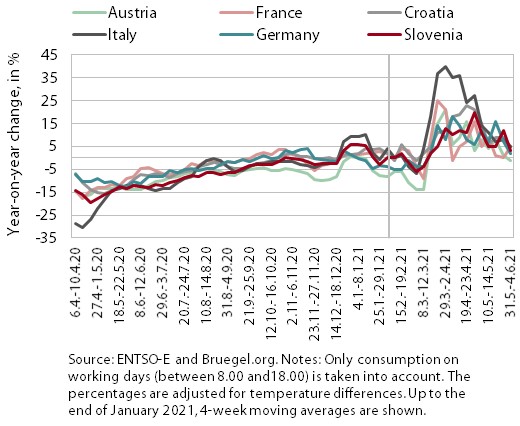
In the week between 31 May and 4 June, electricity consumption was 3% higher than in same week of 2020 but 7% lower than in the same week of the pre-crisis year 2019. The reason for the year-on-year higher consumption was last year’s low base. However, consumption remained lower than before the crisis despite the relaxation of a number of containment measures. Particularly due to the base effect, year-on-year higher consumption was also recorded in Slovenia’s main trading partners (5% in France, Italy and Croatia and 2% in Germany), except in Austria, where it was 1% lower. Relative to the same week of 2019, consumption was down in Italy (10%), Austria (6%) and Germany (2%), while consumption in France and Croatia remained more or less unchanged.
Electricity consumption by consumption group, May 2021
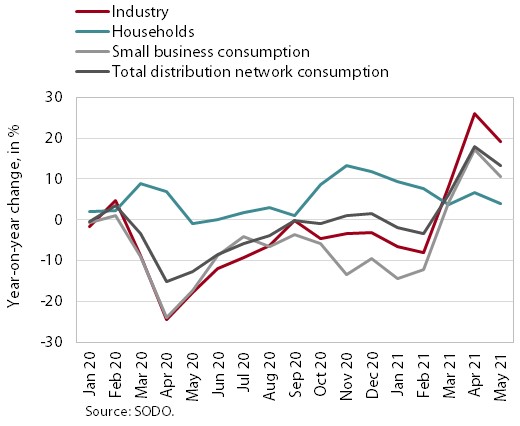
In May, industrial electricity consumption and small business electricity consumption were higher than in the same period last year, and their shortfall compared to the same period in the pre-crisis year 2019 was smaller than in the previous month. In May, industrial electricity consumption was up 19.1% and small business electricity consumption was up 10.6% year-on-year. This is mainly due to last year's low base, when electricity consumption was significantly lower during the first wave of the epidemic due to containment measures and the resulting lower foreign demand, supply chain disruptions and production shutdowns at certain companies. Household consumption was also higher year-on-year, by 4%. Relative to May 2019, industrial consumption was down 2.1% (in April 4.9%) and small business consumption was down 8.7% (in April 10.9%), while household consumption was 3.1% higher.
Registered unemployment, June 2021
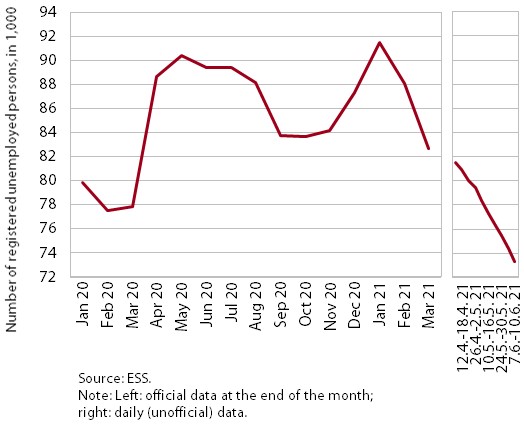
The number of registered unemployed persons fell further at the beginning of June. In May, the decline in the number of unemployed strengthened slightly and this trend continued in the beginning of June. Amid seasonal impacts, which did not deviate significantly from those in the period before the epidemic, the decline was also related to the gradual relaxation of containment measures and economic recovery. On 10 June, 72,957 persons were unemployed according to ESS unofficial (daily) data, which is 2.9 % less than at the end of May and around 18 % less than one year earlier. Compared with June 2019, the number was, however, around 3% higher.
Trade in goods, April 2021
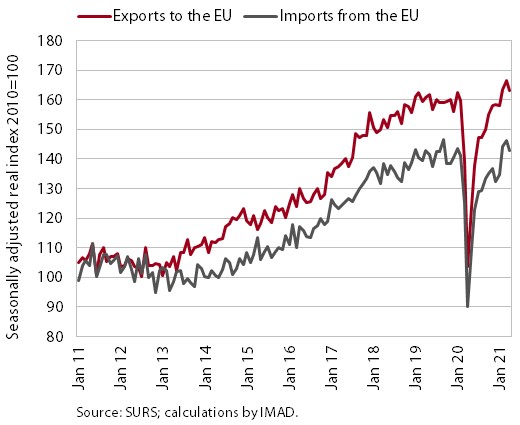
After an increase at the beginning of the year, trade in goods remained at a high level in April. Real merchandise exports and imports to EU countries have been above the pre-crisis levels since late last year, with more pronounced monthly fluctuations due to changes in containment measures in Slovenia and among its trading partners. In our view, this is also related to the interruption in growth in April, as containment measures were introduced in several countries in the weeks around Easter. Despite the restrictions, the measures taken had far less negative impact on trade than during the first wave of the epidemic. It should be noted that the high year-on-year trade growth in the first four months of this year is partly due to very weak activity in March and April last year (base effect). The prospects remain favourable, as export expectations improved in May and companies are more optimistic about future foreign demand than before the start of the epidemic.
Production volume in manufacturing, April 2021
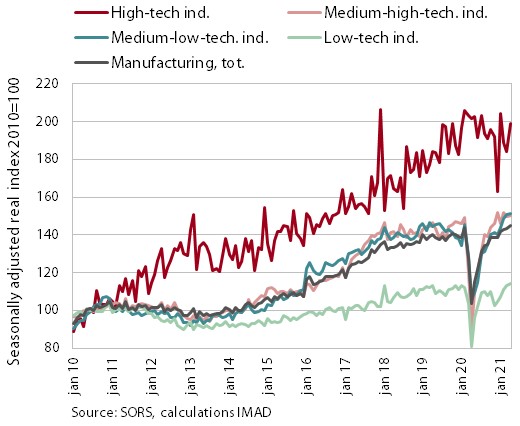
Manufacturing production picked up slightly in April, largely due to a rebound in high-technology industries. Growth continued to be recorded also in low-technology industries, while the production volume in medium-low and medium-high technology industries remained at the previous month’s level. Year-on-year, production in manufacturing recorded high growth, mainly due to last year's low base, as production volume was in line with that of the same period in 2019. Year-on-year growth was highest in medium- and low-technology industries, while production volume remained the same in high-technology industries. At the sector level, the highest year-on-year growth was recorded in the automotive industry, but production volume in April was still far behind that of the same period in 2019.
